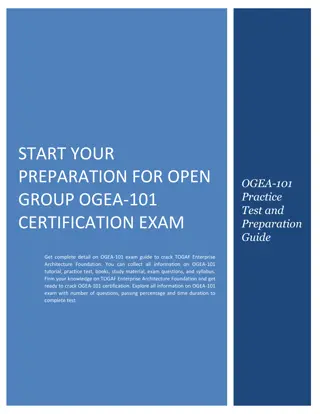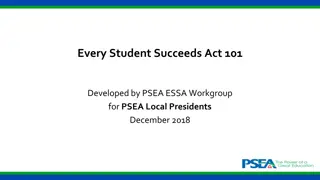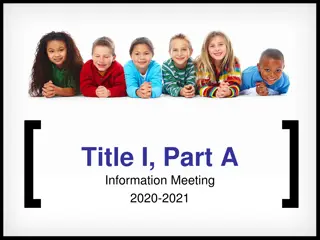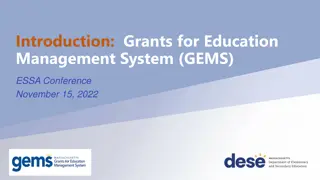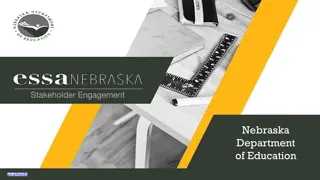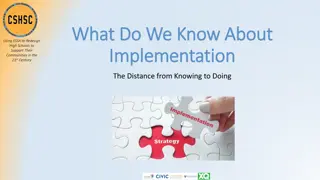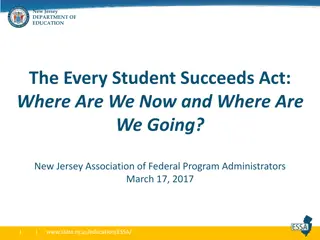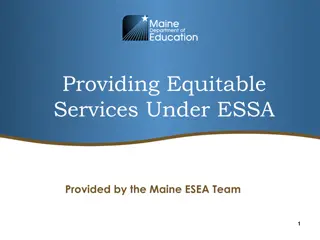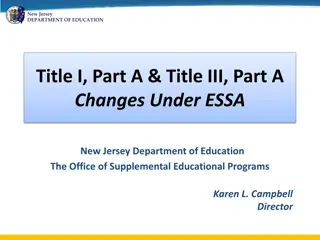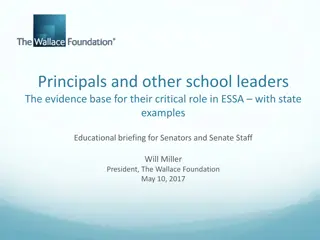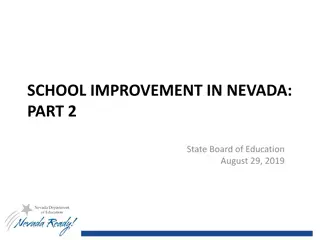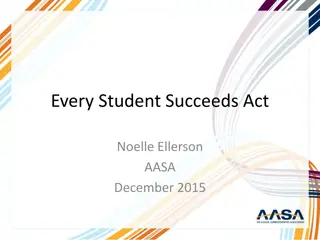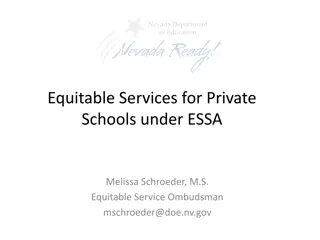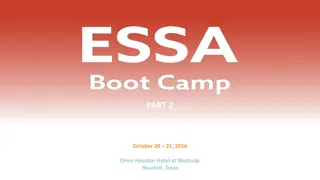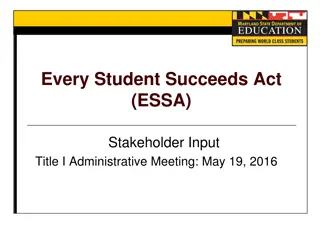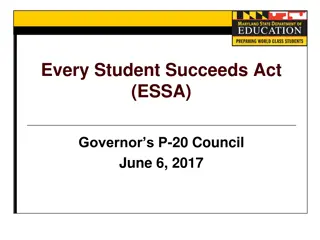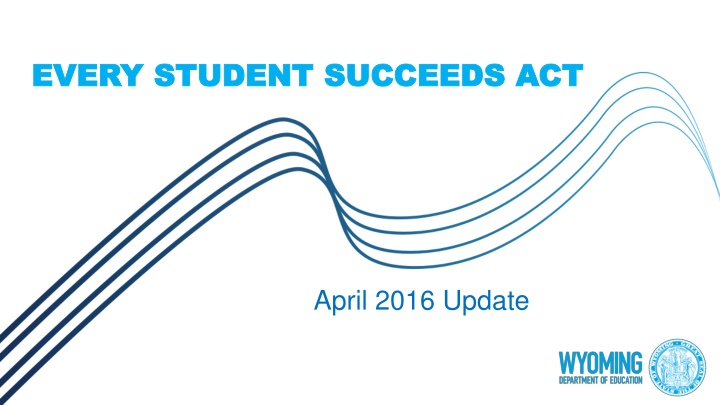
Every Student Succeeds Act
Explore the Every Student Succeeds Act (ESSA) and its impact on education, accountability, standards, assessments, and more. Discover how ESSA provides states with flexibility while ensuring student success and holding stakeholders accountable for results.
Download Presentation

Please find below an Image/Link to download the presentation.
The content on the website is provided AS IS for your information and personal use only. It may not be sold, licensed, or shared on other websites without obtaining consent from the author. If you encounter any issues during the download, it is possible that the publisher has removed the file from their server.
You are allowed to download the files provided on this website for personal or commercial use, subject to the condition that they are used lawfully. All files are the property of their respective owners.
The content on the website is provided AS IS for your information and personal use only. It may not be sold, licensed, or shared on other websites without obtaining consent from the author.
E N D
Presentation Transcript
EVERY STUDENT SUCCEEDS ACT EVERY STUDENT SUCCEEDS ACT April 2016 Update
Presentation Overview How we got here ESSA highlights Impact on Standards, Assessments, and Accountability Measures Changes to School Improvement Interventions Effects on Teacher and Leader Quality Transition Timeline ESSA Implementation Details
Background The Elementary and Secondary Education Act (ESEA) was first passed in 1965, emphasizing equal access to education for all children.
Accountability in Wyoming In 2012, the Wyoming Accountability in Education Act was signed into law, creating a new state accountability system for Wyoming.
Every Student Succeeds Act The Every Student Succeeds Act (ESSA) reauthorizes the Elementary and Secondary Education Act to create a long-term, stable federal policy that gives states additional flexibility and encourages innovation, while at the same time holding us accountable for results.
ESSA Highlights Limits power of federal government to set education policy for states Increases state flexibility to design accountability systems, interventions and student supports Increases state and local flexibility in the use of federal funds Gives states flexibility to work with local stakeholders to develop educator evaluation and support systems Maintains annual assessments for grades 3-8 and high school
Standards The Every Student Succeeds Act reinforces state authority over standards, accountability, and other key education policies. It prohibits any U.S. Secretary of Education from requiring or incentivizing states to adopt specific standards, assessments, teacher evaluation methods, or other key policies. The law does require that state standards are aligned with college and career skills, but defers to states on how to define such alignment.
Assessments Each state is required to have implemented a set of high-quality student academic assessments in math, reading or language arts, and science. Assessment timelines from current law are maintained. Assessments may, at the state s discretion, measure individual student growth. States may use computer-adaptive assessments and may measure a student's academic proficiency above or below grade level and use such scores in the state accountability system.
Assessments (cont.) States may allow an LEA to use a nationally-recognized high school academic assessment in lieu of a state assessment as long as such assessment is aligned to the State's standards and meet other requirements. The law allows, but does not require, states to set a limit on the amount of time devoted to assessment administration for each grade.
Accountability Each statewide system must meaningfully differentiate schools using: Academic proficiency on state assessments Graduation rates for high school English Language Proficiency Growth or another statewide academic indicator for K-8 schools Not less than 1 other state-set indicator of school quality or student success 95% assessment participation rate
School Improvement States must use evidence-based interventions. Specific school improvement models are no longer required.
School Improvement (cont.) Comprehensive Support and Improvement: Lowest-performing 5% of Title I schools on state accountability index; High schools with <67% graduation rates, and Schools with underperforming subgroups that do not improve after a state- determined number of years. Targeted Support and Improvement: Schools with consistently underperforming subgroups, as defined by the state.
Teacher and Leader Quality The Every Student Succeeds Act does not require specific educator evaluation measures or methods. The law does allow, but does not require, states to use Title II funds to implement teacher evaluations. Title II Part A allows states to fund their priorities in attracting, preparing, supporting and retaining effective teachers and leaders to serve high- poverty, minority students.
Teacher and Leader Quality (cont.) ESSA authorizes new allowable federal funding for states to develop and implement: Teacher and School Leader Academies Activities to support principals (new 3% Title II set-aside) Educator training on the use of technology and data privacy Review of state certification, licensure, and tenure systems Development and implementation of teacher evaluation and support systems Other state educator workforce priorities
Transition Timeline Familiarize stakeholders with the new law Now Transition period to work with stakeholders to develop state plans School Year 2016-17 New state plans in compliance with ESSA will go into effect School Year 2017-18
Whats Happened So Far Adequate Yearly Progress (AYP) is no more. NCLB improvement interventions will continue to be implemented for one more year with two exceptions: No requirement to provide school choice, Supplemental Educational Services, or notice to parents Year 4 Planning for Restructuring is suspended The Highly Qualified Teacher Requirements will remain in place through the end of the 2016-17 school year.
What You Can Expect Not everything to change A focus on helping all students grow and improving all schools To participate in the process A state plan to be submitted for full implementation Adjustments to Wyoming s state accountability system Additional guidance from the U.S. Department of Education as the rulemaking process continues
What Were Still Figuring Out Best way to involve all stakeholders How to change mindset from compliance to responsibility The best technical assistance to give school districts How to define new terms in ESSA Funding impacts to school districts and state
Contact Us [Presenter Info] edu.wyoming.gov


